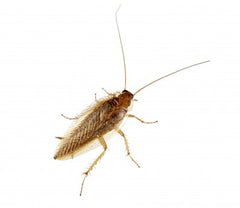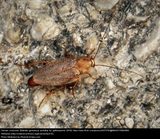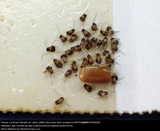Get Rid of German Roaches Without Sprays: 5 Step Guide

Cockroaches have proven to be one of the most adaptable, resilient creature ever to have inhabited the earth, with fossil evidence dating back more than 300 million years. Today there are more than 3,500 known species, with just over 50 of them found in the United States. Of those, no cockroach has been as formidable an opponent as the dreaded German Cockroach.
Why are German Roaches such a problem?
Many, in fact overwhelmingly most, cockroach species make their natural habitat in the outdoor environment. The German Cockroach, however, is almost exclusively an indoor roach, commonly occurring in human-occupied spaces such as commercial kitchens, restaurants, food processing plants, buses, trains, hotels, motels, schools, hospitals, homes, institutional facilities, and just about any place humans tend to congregate. German cockroaches produce more eggs per capsule and have the shortest amount of time from hatching until sexual maturity, resulting in a rapid, often explosive rate of population growth. Their ability to adapt to any environment, flourish in inaccessible areas, feed on just about anything, reproduce at alarming rates, and develop resistances to toxicants makes them particularly challenging to contend with.
What do German Roaches look like?


Not surprisingly, german roaches look like...you guessed it...roaches. They are one of the smaller roach species, tan to light brown in color, with adults typically reaching no more than 1/2" - 5/8" in length. The German Cockroach is most easily identified by this small size along with two dark parallel lines running from the back of the head to the wings, which are not used for flight. Nymphs, or immature stages of German Roaches still in development, look similar to adults but smaller, and will not yet have wings. In homes, German Cockroaches are often found in kitchens and bathrooms, where warmth and moisture is abundant, but can expand throughout the entire house if left unaccounted for.
Sanitation is the key to cockroach avoidance
Unlike bed bugs, which are not specifically associated with poor sanitation, german cockroach populations flourish in such unsanitary environments. Although they tend toward starches, sweets, grease, and various meat by-products, they will readily feed on a wide variety of matter. In many instances, grease, oil, decaying matter, and even trash is sufficient. The best defense against a German Cockroach introduction is maintaining a sanitary environment, and resolving an active roach infestation will similarly depend upon a commitment to sanitation.
As with other cockroach species, German Cockroaches are most active at nighttime as they begin to forage for food. During daylight hours, roaches tend to remain hidden in cracks, crevices, or other sites that provide a warm and humid environment protected from the elements. Noticing live roaches crawling around during the day is usually indicative of an advanced cockroach infestation or a population that has become stressed due to lack of food or introduction of pesticide products.
How fast do German Roaches reproduce?
Female German Cockroaches produce an egg capsule that is about 1/4 inch long containing up to 48 eggs. Under ideal conditions, a new german roach egg capsule can be produced about every 6 weeks, and adult females usually produce between four and eight egg capsules during their lifetime. In as few as 24 weeks, a single female can directly produce nearly 200 baby roaches, with thousands more as direct descendants. Gravid female German Cockroaches carry their egg capsules as a protrusion from their abdomens until hatching time at which point they are deposited into cracks, crevices, joints and other protected locations. On average, a typical German Cockroach may live between 20-30 weeks, and more than 10,000 descendants can be produced in less than a year's time from just two generations of roaches.
How to eliminate German Roaches
Dealing with German Cockroaches, especially advanced infestations, can be terribly challenging, frustration, and unsettling. As with many pests, committing to a defined pest control strategy can help you systematically eliminate the roach problem and keep them from ever coming back. These 5 easy steps to German Cockroach elimination will make your treatment strategy as hassle-free as possible:
 Step 1. Vacuum everywhere. Curiously, few professional exterminators begin with this critical first step to German Cockroach control, and of those that do, few do it well. But it is a critical, valuable first step, that has many specific benefits. Vacuuming not only immediately removes live adult German Roaches from the environment, it also removes dead roaches, roach eggs, roach nymphs, roach harborage, and debris that may become sources of roach food. In order to be effective, the vacuuming process has got to be entirely comprehensive. That usually means pulling out all appliances (refrigerator, stove, dishwasher, microwave), removing outlet switch plates, emptying kitchen cabinets, drawers, and pantries, and eliminating all clutter so that an vacuum extension wand with a crevice attachment tool can be used such things out of all tight spaces. Yes, we know that vacuuming is unlikely to remove ALL of the live roaches or ALL of the roach egg casings, but the mission is to remove as many of them as possible to jump-start our roach treatment program. When vacuuming, be sure to use a vacuum with a disposable inner bag and discard the contents in a sealed container outside the home.
Step 1. Vacuum everywhere. Curiously, few professional exterminators begin with this critical first step to German Cockroach control, and of those that do, few do it well. But it is a critical, valuable first step, that has many specific benefits. Vacuuming not only immediately removes live adult German Roaches from the environment, it also removes dead roaches, roach eggs, roach nymphs, roach harborage, and debris that may become sources of roach food. In order to be effective, the vacuuming process has got to be entirely comprehensive. That usually means pulling out all appliances (refrigerator, stove, dishwasher, microwave), removing outlet switch plates, emptying kitchen cabinets, drawers, and pantries, and eliminating all clutter so that an vacuum extension wand with a crevice attachment tool can be used such things out of all tight spaces. Yes, we know that vacuuming is unlikely to remove ALL of the live roaches or ALL of the roach egg casings, but the mission is to remove as many of them as possible to jump-start our roach treatment program. When vacuuming, be sure to use a vacuum with a disposable inner bag and discard the contents in a sealed container outside the home.
 Step 2. Declutter and Sanitize. It is important that step 2 immediately follow step 1. Not 3 days later. Or a week later. Or a month later. Like immediately. Now that you've vacuumed the impacted environment, it's time to have the area decluttered (clutter creates a ton of potential roach harborage areas that can complicated the roach treatment process) and then comprehensively sanitize. Use this as an opportunity to organize the area and discard any trash or debris that may not be essential. When dealing with a German Cockroach outbreak, the less things you have in the area, the better. After minimizing, clean and sanitize anything that remains. This includes floors, baseboards, cracks and crevices, appliances, walls, inside drawers and cabinets...absolutely everyplace.
Step 2. Declutter and Sanitize. It is important that step 2 immediately follow step 1. Not 3 days later. Or a week later. Or a month later. Like immediately. Now that you've vacuumed the impacted environment, it's time to have the area decluttered (clutter creates a ton of potential roach harborage areas that can complicated the roach treatment process) and then comprehensively sanitize. Use this as an opportunity to organize the area and discard any trash or debris that may not be essential. When dealing with a German Cockroach outbreak, the less things you have in the area, the better. After minimizing, clean and sanitize anything that remains. This includes floors, baseboards, cracks and crevices, appliances, walls, inside drawers and cabinets...absolutely everyplace.
 Step 3. Place German Cockroach Monitors. After you've vacuumed, cleaned, decluttered, and sanitized, it's time to start to understand the extent of the remaining roach infestation and zero in on where the cockroach harborage areas may be. Most cockroach monitors will come in the form of easy to use glue board sticky traps that can be placed in areas where German Cockroach activity is suspected. Start by placing a series of roach traps every 3 or 4 feet throughout the environment, including one in each draw, cabinet, or shelf. Place one behind the refrigerator and stove, beneath the sink, around the dishwasher, around plumbing penetrations, next to microwaves and coffee pots, and along straight edges of floors and walls. Because German Roaches typically travel no more than a few feet from their harborage in search of food, many roach monitors should be used initially. Not only will these monitors provide an indication how widespread the roach populations are, they will also provide critical insight into where the roach harborage areas may be. After placing your initial round of roach monitors, leave the traps undisturbed for the first 3-4 days, and then begin to examine your findings. Monitors with heavy concentrations of roaches indicate a pocket or high roach population in the area immediately around that monitor.
Step 3. Place German Cockroach Monitors. After you've vacuumed, cleaned, decluttered, and sanitized, it's time to start to understand the extent of the remaining roach infestation and zero in on where the cockroach harborage areas may be. Most cockroach monitors will come in the form of easy to use glue board sticky traps that can be placed in areas where German Cockroach activity is suspected. Start by placing a series of roach traps every 3 or 4 feet throughout the environment, including one in each draw, cabinet, or shelf. Place one behind the refrigerator and stove, beneath the sink, around the dishwasher, around plumbing penetrations, next to microwaves and coffee pots, and along straight edges of floors and walls. Because German Roaches typically travel no more than a few feet from their harborage in search of food, many roach monitors should be used initially. Not only will these monitors provide an indication how widespread the roach populations are, they will also provide critical insight into where the roach harborage areas may be. After placing your initial round of roach monitors, leave the traps undisturbed for the first 3-4 days, and then begin to examine your findings. Monitors with heavy concentrations of roaches indicate a pocket or high roach population in the area immediately around that monitor.
 Step 4. Introduce a Cockroach Insect Growth Regulator (IGR) I know...this sounds complicated, right? Nope. This is probably the easiest part of your German Cockroach control program. Thanks to the simplicity of an IGR called Gentrol Point Source, using an IGR is as easy as placing a little plastic disc in the roach impacted area. The IGR specifically impacts immature stages of roaches, effectively impeding the reproductive process and preventing continual and perpetual repopulation. Because German Roaches are prolific breeders, incorporation of an IGR is essential to ensure success of the program.
Step 4. Introduce a Cockroach Insect Growth Regulator (IGR) I know...this sounds complicated, right? Nope. This is probably the easiest part of your German Cockroach control program. Thanks to the simplicity of an IGR called Gentrol Point Source, using an IGR is as easy as placing a little plastic disc in the roach impacted area. The IGR specifically impacts immature stages of roaches, effectively impeding the reproductive process and preventing continual and perpetual repopulation. Because German Roaches are prolific breeders, incorporation of an IGR is essential to ensure success of the program.
 Step 5. Introduce Cockroach Gel Baits. If steps 1-4 have been properly followed, you should now be about 5-7 days into your German Roach treatment program. Using the information gathered from strategic placement of your roach monitors, you now have good sense of where the remaining roaches are concentrated, and you can begin making targeted roach gel bait applications. In addition to using the information from the monitors to help you determine where to make your roach bait placements, the 5-7 day delay is important for other reasons as well. At the time of vacuuming and sanitizing, the roaches will become stressed and may begin to scatter. Roaches in a state of stress tend not to feed readily for a period of time. By allowing a few days before baiting, you will allow the remaining roaches, at least to some extent, to settle back into their environment, and the limited food resources brought about by your sanitization will encourage them to be on the lookout for new options, hopefully your bait. When making bait placements, be sure follow the label instructions for how and where to apply. For most gel baits, placements are typically best made as targeted pea-sized pin placements every 12-18 inches in proximity to areas of suspected roach harborage. a gradual reduction in the roach population over a period of days or weeks (depending on the extent of the infestation) until the entire population has been eliminated. During this process, be sure to keep plenty of fresh bait on hand, and protect all bait placements from contamination via cleaners, chemicals, or pesticides. For this reason, most pesticides are not generally advisable in combination with a cockroach baiting program. Continue using your roach monitors throughout the baiting program so that you can gauge the progress and determine when success has been achieved.
Step 5. Introduce Cockroach Gel Baits. If steps 1-4 have been properly followed, you should now be about 5-7 days into your German Roach treatment program. Using the information gathered from strategic placement of your roach monitors, you now have good sense of where the remaining roaches are concentrated, and you can begin making targeted roach gel bait applications. In addition to using the information from the monitors to help you determine where to make your roach bait placements, the 5-7 day delay is important for other reasons as well. At the time of vacuuming and sanitizing, the roaches will become stressed and may begin to scatter. Roaches in a state of stress tend not to feed readily for a period of time. By allowing a few days before baiting, you will allow the remaining roaches, at least to some extent, to settle back into their environment, and the limited food resources brought about by your sanitization will encourage them to be on the lookout for new options, hopefully your bait. When making bait placements, be sure follow the label instructions for how and where to apply. For most gel baits, placements are typically best made as targeted pea-sized pin placements every 12-18 inches in proximity to areas of suspected roach harborage. a gradual reduction in the roach population over a period of days or weeks (depending on the extent of the infestation) until the entire population has been eliminated. During this process, be sure to keep plenty of fresh bait on hand, and protect all bait placements from contamination via cleaners, chemicals, or pesticides. For this reason, most pesticides are not generally advisable in combination with a cockroach baiting program. Continue using your roach monitors throughout the baiting program so that you can gauge the progress and determine when success has been achieved.
There is absolutely no shame in going straight for the pros. Those that do often enjoy faster, longer lasting results than those that choose to do their own pest control. Click here to find a licensed pest control company in your area now.
